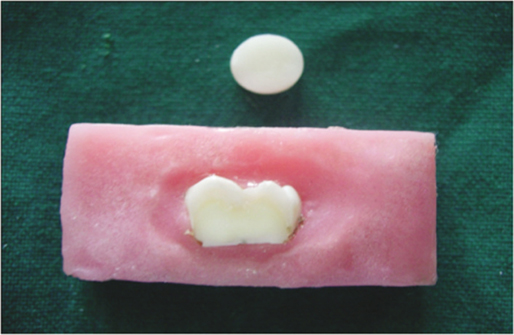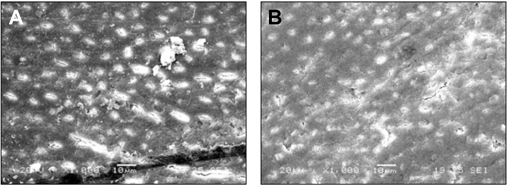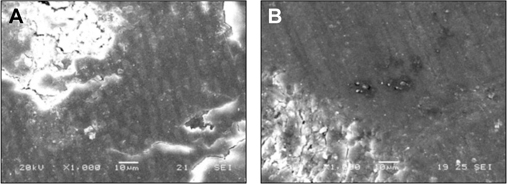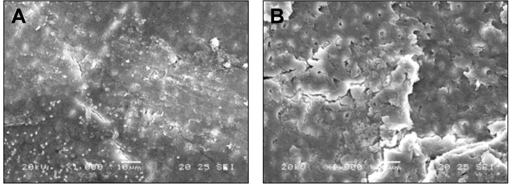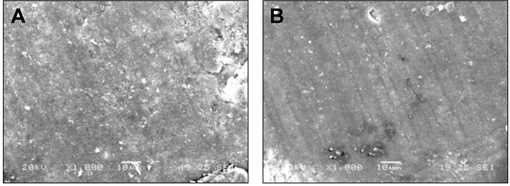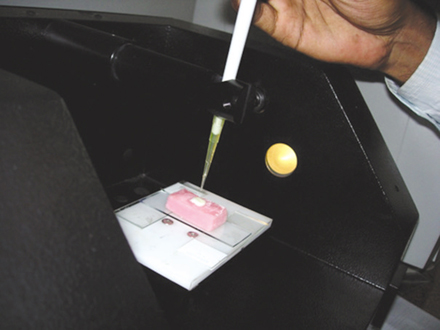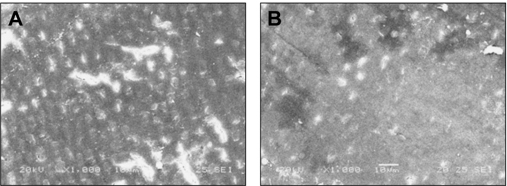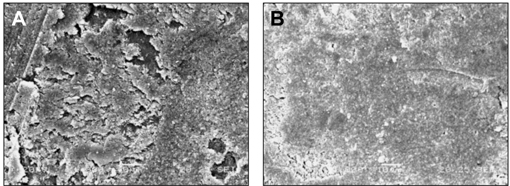J Adv Prosthodont.
2012 Aug;4(3):139-145. 10.4047/jap.2012.4.3.139.
Efficacy of various cleansing techniques on dentin wettability and its influence on shear bond strength of a resin luting agent
- Affiliations
-
- 1Department of Prosthodontics, SRM Kattankulathur Dental College, Chennai, India. dilipcanine@gmail.com
- 2Department of Orthodontics, SRM Kattankulathur Dental College, Chennai, India.
- 3Department of Prosthodontics, JKK Natarajah Dental College, Komarapalayam, India.
- KMID: 2176408
- DOI: http://doi.org/10.4047/jap.2012.4.3.139
Abstract
- PURPOSE
To evaluate the shear bond strength of resin luting agent to dentin surfaces cleansed with different agents like pumice, ultrasonic scaler with chlorhexidine gluconate, EDTA and the influence of these cleansing methods on wetting properties of the dentin by Axisymmetric drop Shape Analysis - Contact Diameter technique (ADSA-CD).
MATERIALS AND METHODS
Forty coronal portions of human third molar were prepared until dentin was exposed. Specimens were divided into two groups: Group A and Group B. Provisional restorations made with autopolymerizing resin were luted to dentin surface with zinc oxide eugenol in Group A and with freegenol cement in Group B. All specimens were stored in distilled water at room temperature for 24 hrs and provisional cements were mechanically removed with explorer and rinsed with water and cleansed using various methods (Control-air-water spray, Pumice prophylaxis, Ultrasonic scaler with 0.2% Chlorhexidine gluconate, 17% EDTA). Contact angle measurements were performed to assess wettability of various cleansing agents using the ADSA-CD technique. Bond strength of a resin luting agent bonded to the cleansed surface was assessed using Instron testing machine and the mode of failure noted. SEM was done to assess the surface cleanliness. Data were statistically analyzed by one-way analysis of variance with Tukey HSD tests (alpha=.05).
RESULTS
Specimens treated with EDTA showed the highest shear bond strength and the lowest contact angle for both groups. SEM showed that EDTA was the most effective solution to remove the smear layer. Also, mode of failure seen was predominantly cohesive for both EDTA and pumice prophylaxis.
CONCLUSION
EDTA was the most effective dentin cleansing agent among the compared groups.
Keyword
MeSH Terms
Figure
Reference
-
1. Ayad MF, Rosenstiel SF, Hassan MM. Surface roughness of dentin after tooth preparation with different rotary instrumentation. J Prosthet Dent. 1996. 75:122–128.2. Terata R. Characterization of enamel and dentin surfaces after removal of temporary cement-study on removal of temporary cement. Dent Mater J. 1993. 12:18–28.3. Grasso CA, Caluori DM, Goldstein GR, Hittelman E. In vivo evaluation of three cleansing techniques for prepared abutment teeth. J Prosthet Dent. 2002. 88:437–441.4. Hülsmann M, Heckendorff M, Lennon A. Chelating agents in root canal treatment: mode of action and indications for their use. Int Endod J. 2003. 36:810–830.5. Rosales-Leal JI, Osorio R, Toledano M, Cabrerizo-Vílchez MA, Millstein PL. Influence of eugenol contamination on the wetting of ground and etched dentin. Oper Dent. 2003. 28:695–699.6. Sarac D, Sarac YS, Kulunk S, Kulunk T. Effect of the dentin cleansing techniques on dentin wetting and on the bond strength of a resin luting agent. J Prosthet Dent. 2005. 94:363–369.7. Hansen EK, Asmussen E. Influence of temporary filling materials on effect of dentin bonding agents. Scand J Dent Res. 1987. 95:516–520.8. Meyerowitz JM, Rosen M, Cohen J, Becker PJ. The effect of eugenol containing and non-eugenol temporary cements on the resin-enamel bond. J Dent Assoc S Afr. 1994. 49:389–392.9. Ngoh EC, Pashley DH, Loushine RJ, Weller RN, Kimbrough WF. Effects of eugenol on resin bond strengths to root canal dentin. J Endod. 2001. 27:411–414.10. Yap AU, Shah KC, Loh ET, Sim SS, Tan CC. Influence of eugenol-containing temporary restorations on bond strength of composite to dentin. Oper Dent. 2001. 26:556–561.11. Kielbassa AM, Attin T, Hellwig E. Diffusion behavior of eugenol from zinc oxide-eugenol mixtures through human and bovine dentin in vitro. Oper Dent. 1997. 22:15–20.12. Duke ES, Phillips RW, Blumershine R. Effects of various agents in cleaning cut dentine. J Oral Rehabil. 1985. 12:295–302.13. Takeda FH, Harashima T, Kimura Y, Matsumoto K. A comparative study of the removal of smear layer by three endodontic irrigants and two types of laser. Int Endod J. 1999. 32:32–39.14. Peters O, Göhring TN, Lutz F. Effect of eugenol-containing sealer on marginal adaptation of dentine-bonded resin fillings. Int Endod J. 2000. 33:53–59.15. Abbott PV, Heijkoop PS, Cardaci SC, Hume WR, Heithersay GS. An SEM study of the effects of different irrigation sequences and ultrasonics. Int Endod J. 1991. 24:308–316.16. Brännström M, Nordenvall KJ, Glantz PO. The effect of EDTA-containing surface-active solutions on the morphology of prepared dentin: an in vivo study. J Dent Res. 1980. 59:1127–1131.17. Cameron JA. Factors affecting the clinical efficiency of ultrasonic endodontics: a scanning electron microscopy study. Int Endod J. 1995. 28:47–53.18. Braga RR, Ballester RY, Carrilho MR. Pilot study on the early shear strength of porcelain-dentin bonding using dual-cure cements. J Prosthet Dent. 1999. 81:285–289.19. Lafuente JD, Chaves A, Carmiol R. Bond strength of dual-cured resin cements to human teeth. J Esthet Dent. 2000. 12:105–110.20. Bayindir F, Akyil MS, Bayindir YZ. Effect of eugenol and non-eugenol containing temporary cement on permanent cement retention and microhardness of cured composite resin. Dent Mater J. 2003. 22:592–599.21. Van Meerbeek B, Inokoshi S, Braem M, Lambrechts P, Vanherle G. Morphological aspects of the resin-dentin interdiffusion zone with different dentin adhesive systems. J Dent Res. 1992. 71:1530–1540.
- Full Text Links
- Actions
-
Cited
- CITED
-
- Close
- Share
- Similar articles
-
- Comparative evaluation of micro-shear bond strength between two different luting methods of resin cement to dentin
- Shear Bonding Strength of Three Cements Luted on Pediatric Zirconia Crowns and Dentin of Primary Teeth
- SHEAR BOND STRENGTH OF PRETREATED DENTIN SURFACE WITH RESIN-REINFORCED GLASS IONOMER CEMENT
- SHEAR BOND STRENGTH OF LUTING CEMENTS TO DENTIN TREATED WITH RESIN BONDING AGENTS
- The Effect Of Temporary Cement And Desensitizer On The Bond Strength Of Luting Cements


